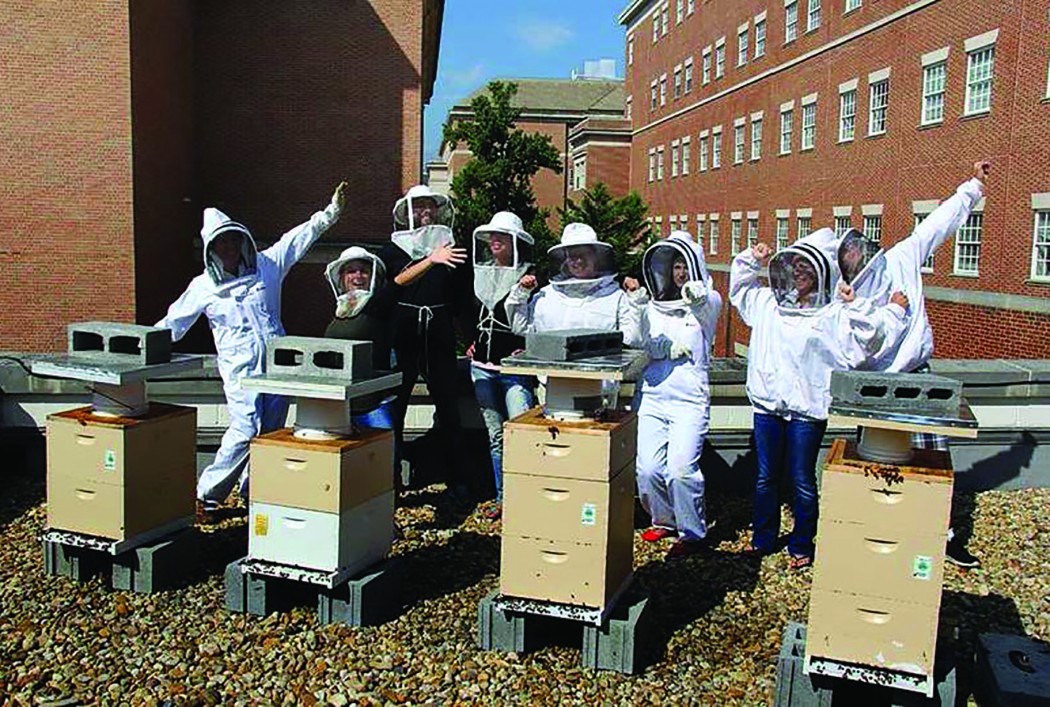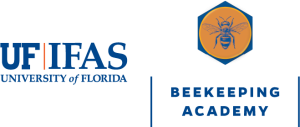by Toni Burnham
Though it was my suggestion, interviewing ten energetic and inspiring young Bee Informed Partnership scientists at once was probably a bad idea. But boy was it ever fun!
A group of BIP researchers joined me for lunch in College Park, including Dr. Dennis vanEngelsdorp, the Project Director; Karen Rennich, Project Manager; Ashley Jones, research assistant with the Sentinel Hive Project; Grace Kunkel, research assistant in charge of the APHIS and National Honey Bee Disease Surveys, Steven Smith, Apiary Manager; Shayne Madella, microbiology researcher and the go to person for viral detection; Heather Eversole, Lab Manager extraordinaire; Rachel Fahey, researcher and the “Gold Standard” Nosema spore counter; and Meghan McConnell, the research assistant working on the “Tier 4” Real Time Disease Load Monitoring Project.
It’s a tight group. Heather shares that, “It’s important that we each bring our own skills and our special research niche, but we travel a lot and it is important that we can back up each other well.” Heather helps balance the sample process flow and personalities as well as running the Vvarroa counts. The team environment is critical so the “fit” is important and other lab members refer to a “work for a day” invitation that they sometimes use to vet whether a potential team member is a good match for them and for the lab. There’s a “lab personality,” the scientists at the table agree. Karen mentions, “We may be too loud and too happy but we really only get into trouble for being too loud.”
The Bee Informed Partnership’s energy is very efficiently expended on a wide but select list of projects designed to place relevant, understandable information tools for honey bee health in the hands of the nation’s beekeepers. The takeaway is that their discoveries are our discoveries, and a way of learning from and teaching ourselves in a way that is different from traditional channels of scientific communication.
Most BeeCulture readers are familiar with the annual National Winter Loss Surveys that BIP has conducted since 2010-2011. Response rates representing around 22% of the nation’s colonies, reflecting the large numbers of colonies held by commercial survey respondents as well as the survey’s reach into the sideliner and hobbyist world. But many other initiatives seemed to be going on, from attempts to get a real time picture of bee disease levels to analyzing viable techniques for improving honey bee health.
Over lunch, the topics we looked at most were BIP’s evolution to an epidemiological, rather than purely entomological, model for improving honey bee health, its real time disease monitoring work and the launch of the Sentinel Hive Project.
The Bee Informed Partnership was launched in Spring 2011, and has come to include efforts like HoneyBeeNet, first started at NASA, and the above mentioned survey, previously run by the Apiary Inspectors of America. The team impressed me with how they had taken advantage of some of the most exciting existing research tools, applied new frames of reference to make them even more relevant to the average beekeeper, and then moved them forward from analyzing past events to monitoring the present and perhaps helping us predict the future health of our colonies.
Getting Down To Business
Though hive scales, surveys, and the associated data were deeply valuable tools and a solid start, Dennis says that BIP still had some lessons to learn. What kind of beekeeping customers did BIP need to serve? What kind of products or services could they most use? According to Dennis, “We thought we knew, but we were wrong. Both Karen (Rennich) and I undertook a multiyear Maryland Technology Enterprise Institute Mtech program designed to help scientists take technological approaches and make them work in the world of business.” This was critical because according to Dennis, “The biggest ‘AHA!’ moment for BIP work with the commercial beekeeping world must be sustainable: if it did not work economically, it did not work at all.” And most hives in North America are commercially managed: the future of honey bee health is therefore largely in the hands of beekeepers with thousands of hives that need to be economically viable.
As part of the Mtech process, Dennis relates “We spent hours talking to beekeepers nationwide, using conferences, meetings, any gathering in which they participated across the country to hear what beekeepers wanted to know, and needed to have, to run sustainable operations. Beekeepers would pull up chairs and sit with us, and speak honestly and at length about what they faced and what they needed.”
The BIP leaders also took classes, which resulted in a sustainable business model that will allow BIP Tech Transfer Teams who do inspections and sampling in the field to continue to serve beekeepers beyond the funding of the project. Also they provide business models which will allow sustainable services like the Emergency Response Kits that help beekeepers better understand the real world factors that may be contributing to crashing colonies, including Nosema, Varroa, and eight viruses.
Starting in 2013, BIP also undertook what was first known as the “Real Time Longitudinal Monitoring Project” with 22 commercial, sideline, and backyard beekeepers around the country. By sampling on a regular monthly basis, rather than just once or twice a year, BIP hoped to develop information that would allow beekeepers to make better decisions about when best to treat. Though subsidized, this program is not free to participating beekeepers: once again, it has to provide value and be sustainable for both parties. This year, this project now includes 100 beekeepers, and there is an option to join the Pollen Trap Collection Project as well, adding the dimension of estimating the level and timing of pollen diversity to the rhythm of disease loads in the apiary. Sweet.
Lessons From Epidemiology
Another major lesson came from the team’s analysis of unexplained colony losses. From the surveys it became apparent that “a significant minority of beekeepers experienced sustainable losses, while a significant majority lost more than they could afford. Analyzing these practices and using tools familiar from human epidemiology – getting more beekeepers the information necessary to adopt practices that could help their bees survive – seemed to offer more promise than hit or miss case study reviews.”
As a result, “We almost never give advice: we give information. This is a lesson we have learned from human epidemiology,” explains Dennis.
Karen chimes in, “But what is that information? What is normal, what is average? What is a dangerous level? Numbers need to be placed in context in order to be useful.” That is where the work of the individual members of the Lab team comes into play. Through both its own and previous survey and data collection, “BIP has more historical records than anyone else, which puts results in context, including national and local conditions, and conditions over time,” says Dennis.
Shayne adds, “We are able to assay viral loads and compare them to expected seasonal fluctuations as well, and point out significant variations. Loads in August versus December vary naturally, and unusual changes can be spotted.” Dennis mentions, “Viral virulence also varies over time.”
So it’s not just a mite drop number or a pollen count or a parts-per-million titer compared to your neighbors, but to beekeepers nationwide and this year and several before. The data can even flag how the load compares to expected levels for the season in which the sample was collected. Adds Meghan, “Without having these averages, beekeepers have no idea what the numbers mean. Is this high or low? Good or bad?”
Which is all kind of looking backward, gleaning information from past conditions. But Bee Informed has taken the knowhow gained through its experience with technology tools like hive scales, the Hive Check Surveys, pollen watching, and real time disease monitoring to take it to the next level: The Sentinel Hive Project (http://tinyurl.com/ph3hhrg).
As this interview is being written, BIP and the University of Maryland have used online crowdfunding of “Sentinel Hives” to set up eight professionally monitored colonies that will include hive scales, pollen traps, and disease monitoring and analysis, with the data automatically posted online and results made available to nearby beekeepers. These hives can function as an early warning system for nectar flows (not just providing a data point for a potential harvest but a heads up for swarm management), provide pollen counts related to measure floral diversity and support for bee nutrition, and timing alerts for potential treatment interventions. It’s a chance for these scientists to take the survey, virus, forage quality, and nectar flow information they have worked with for the past four years and use it for a kind of bee health forecast, potentially the first ever available to both commercial and sideline beekeepers.
If the effort makes more than their $8,000 seed money, they will place one additional “sentinel” hive in the field for every $1,000 raised, setting up additional hives both in and outside of Maryland. And as of this writing there are sites outside Maryland that are hoping to sign up.
The ideas hardly stop there. The Bee Informed Partnership team also held out enticing prospects clearly designed to snag the imagination of an urban apiculturalist. Dennis tempts me with epidemiology: “There are examples of conquering cow diseases by having all the herds in an area treated simultaneously for the same disease, denying the pathogen a reservoir in the habitat. What if we did a pilot where downtown beekeepers all treated in the same week? What if we got 75% of the DC queen breeders to develop from hygienic stock? City beekeepers are uniquely placed to have concentrated influence over their geographic area. We could try it and measure the results.”
So guess who really wants a Sentinel Hive now?
High-tech hive or not, I’m hoping to have many opportunities to speak with and work with the Bee Informed Partnership team on an ongoing basis, and it’s clear that they have a major goal of hearing from and sharing information with you, as well. This interview barely scratched the surface of the team’s accomplishments in the mere four years since they launched, not to mention all the potential for our beekeeping future. I am so lucky to have them available for lunch: do your best to get one of their Sentinel Hives, and you can have them in your backyard, too.
Toni Burnham keeps bees on rooftops in the Washington, DC area where she lives.









